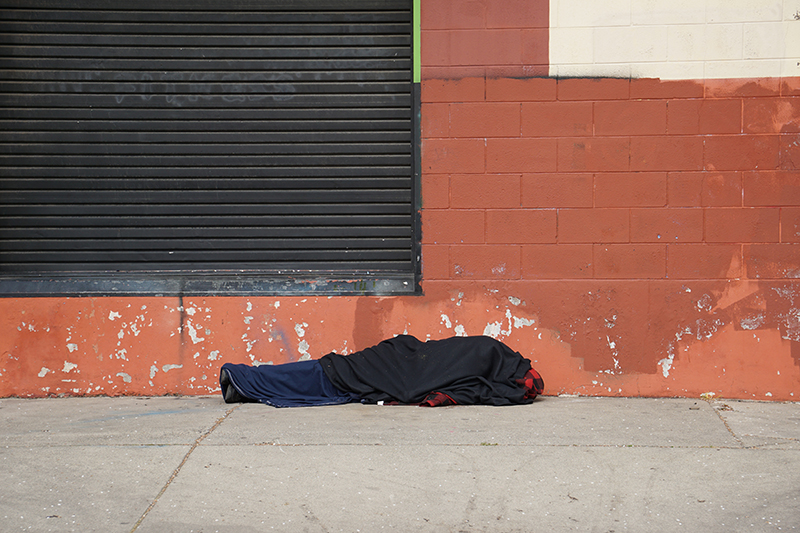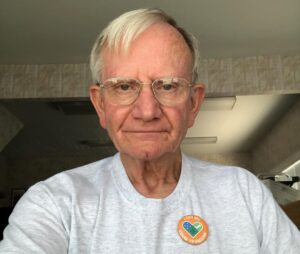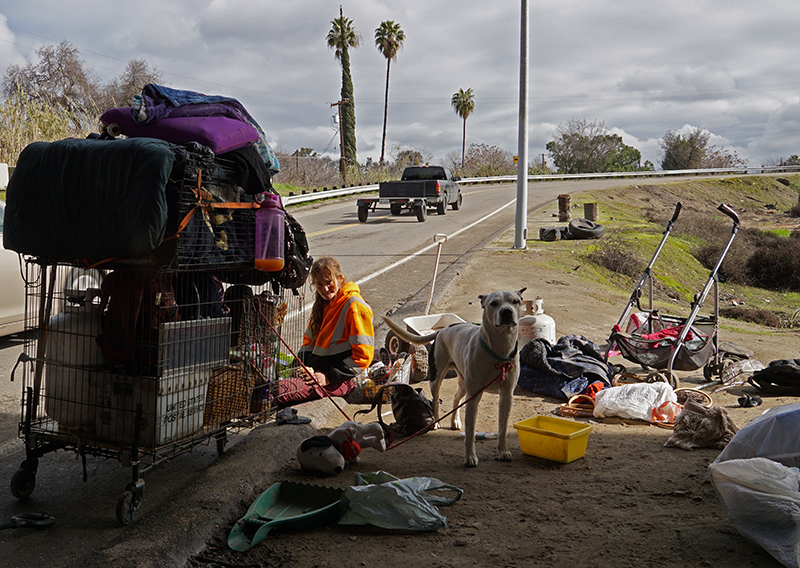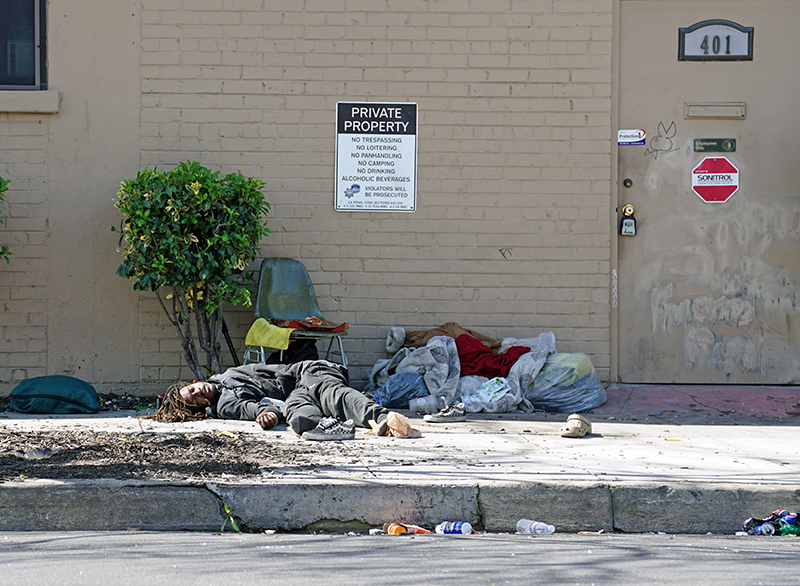As this winter’s often heavy rains repeatedly drenched numerous streets and alleyways here in the city of Modesto, I ran across the inevitable evidence — when I ventured out, usually in the aftermath of a downpour — of the toll those storms were taking on the most vulnerable among us, i.e., our unhoused neighbors who are at the mercy of the high winds, the cold rain, and the clinging chill of their own soaked clothes.
When going out to catch the bus one day, I spied a soggy green sweater piled in a heap by the bench. A few days later, following another storm, I ran across a sleeping bag — still drying out — at the corner of Bowen & McHenry — abandoned, no doubt, because it had become too uncomfortable and heavy with sogginess for its owner to keep hauling from one sleeping spot to the next.
Another time, it was a couple of mismatched shoes with several stray socks stuffed in them. These aren’t bits of garbage so much as little reminders that many people in our city are existing at a very difficult level indeed.

And, in a February 29th article published in Cal Matters, Marisa Kendall pointedly writes of just how dangerous survival out on the streets has become:
“For many people, living on the streets of California is a death sentence. That’s according to a recent study that took the first deep look into mortality rates in homeless communities throughout the country. It found the death rate more than tripled between 2011 and 2020. The findings make it clear that, at the same time, the number of homeless Californians is soaring; it’s also becoming more dangerous to be homeless. And it means the stakes are sky-high when it comes to state and local efforts to combat the crisis: People’s lives are on the line The number of Californians 55 and older who sought homelessness services soared 84% between 2017 and 2021
The Modesto Citizen’s Action Group (MoCag) was formed just about a year ago by a group of concerned local citizens who, collectively, had provided a great deal of care, attention, and support to the multifaceted issues of homelessness in our community over an extended length of time. Many members of MoCag know the individuals and families who are the faces of the unhoused in Modesto – our neighbors – people who not only respect them in return but who have earned their trust and their friendship as well.

So, the other day, I caught up with James Costello, who was one of MoCag’s founding members, to find out what MoCag has been doing recently and what plans it has for the near future.
- Please describe MoCag’s original goal, and what actions it took in 2023 as an advocate for the unhoused in our community.
James Costello: MoCAG was created to address a certain portion of the homeless population in Modesto and, ultimately, hopefully, around the County. It is true that the City of Modesto and Stanislaus County have done a great deal for various populations of the homeless, but there’s one group that MoCag wanted to focus on – those are the homeless individuals who are in the streets, parks, and doorways who camp pretty much anywhere they can find – along roadways, freeways.
Following a great deal of research, MoCag came up with a plan to get people off the street and into transitional housing, which might include tents, pallet shelters, or other types of shelter. The whole idea is to create a space where an individual can safely store his or her belongings and pets, and rest because it is hard to sleep on the streets. Homeless people are continually being rousted by law enforcement, having their documents stolen, their tents destroyed. We discussed our plan with all the members of the City Council and with each of the members of the Stanislaus County Board of Supervisors. We went into detail about the plan and what we would like to see happen.
Since it is mainly a City of Modesto problem, we have consistently addressed the City Council. We have presented almost every rational plan that could be thought of to try and deal with the problem for this particular population of the unhoused. However, the City Council did not really accept our recommendation. Three of the City Council members were on board and created their own plan to help move people from the streets to a transitional shelter. Their plan was rejected in a 4-3 vote by the City Council in October 2023.
- In the wake of that vote, how did MoCag react, and what are its current plans?
James Costello: We at MoCag are very disconcerted about this because we presented viable ways to solve this problem, as did the three Councilmembers, Bavaro, Ricci, and Alvarez. However, the City Council, at this point, has decided not to address that population of homelessness, even though many other cities in California are doing so. The city of Manteca is one example. They have established a pallet shelter home, with services, security, and other things that homeless people need. And it’s apparently working well.

So, currently, the members of MoCag have realized that we must take another approach. We don’t want to just sit idly by and not try to do anything. We have recently met with a councilmember, and we are trying to work through the private sector, and we are creating a plan to do that. We will be contacting councilmembers and supervisors about how this might be done. That’s a work in progress, and something that we are very hopeful will gain traction.
One idea is to find land in Modesto – private land or government-owned land – that might be used to establish where shelters or pallets might be placed. The other part of this idea is to focus on particular groups. Rather than having a one-size-fits-all approach, there are various subdivisions of this population. Say pallets for families, for example.
- Briefly describe Bridge Housing, and how the City of Modesto is involved in a program to fund building units of it here in our community.
James Costello: One of the aspects that the City of Modesto is pursuing is called Bridge Housing whereby land owned by private entities (such as churches) can be used to temporarily house certain people who are homeless. As an example, the Modesto Church of the Brethren has applied to be a Bridge Housing provider for families with children. The City of Modesto has allocated $3 million for the Bridge Housing initiative. Other agencies and churches may also be applying for these dollars. The city has committed to purchasing shelters and doing infrastructure work on the various properties that receive the funding. But Bridge Housing is not designed to address the population that MoCag has dedicated its efforts to assisting – the chronic, severely homeless. These individuals are not really suitable for Bridge Housing.

- Please describe why seeking a shelter – say at the Berberian or Mission Gospel – isn’t possible for some unhoused individuals:
James Costello: It’s true that there are shelters for the people who live on the street. However, some people can’t live in the shelters. They’ve been afraid, or they are not psychologically capable of living in a group situation. Many of the homeless are psychologically scarred by the experience of being homeless and needing to go into survival mode. If you stay homeless for a long time, then your entire outlook on life changes. Some homeless people who get into a house don’t sleep in the bed; they sleep on the floor – they need to be re-acculturated to learn how to live in a house. And they need other psychological services as well. That doesn’t count the ones who are drug addicted. Homeless people often sleep in the daytime because it’s safer to sleep during the day – at nighttime, you – and particularly women – are subject to attack, rape, robbery, beatings, whatever. It’s a horrible way to live and carries a lot of trauma with it. That idea seems to get lost in the City Council’s evaluation of the problem. There are some people who just can’t go to shelters. The City has a program to help people with those issues. It’s called Camp to Home. It’s got lots of components to it that – and, if it works – should be successful. However, one of the things we’ve found, by talking to people who actually deal with homelessness on the street is that to get services there are often bureaucratic impediments for people along the way.
- Does MoCag have any other goals the group is currently working on?
James Costello: Yes. Another of our goals is to call for a partnership between the City and the County. The City of Modesto has some funding available through Measure H. However, the County has a lot of money that they could use for these purposes in conjunction with the City of Modesto. That’s the whole idea of getting them together and seeing what we can come up with.

- Please briefly describe why you think MoCag remains so committed to helping in this cause…in effect, to helping our neighbors in their time of need?
James Costello: First, I think the people sitting on the City Council are good people. They have done a good deal for the homeless in our community. They mean well, but there’s a wall they won’t cross to build an action to help this group – the hundreds who, at this very moment, are enduring another night of cold temperatures. Before long, though, the summer will be upon us – with its searing heat – and still nothing has been built for those fighting to survive on the street. We at MoCag will continue to advocate and fight for those individuals, many of whom we know by name and face – for, too often, their voices remain unheard in this city, their dangerous plight left to fester and only worsen with each passing day.

My family has been living in hotels for almost 8 years. We need help with a deposit. We don’t know where to turn to, can you help us.
Hi Vicki. Call Frank at 209-556-2376 or Steve at 209-993-4984 and we’ll see what we can do.
Have you tried CHSS?
https://www.communityhousingandshelterservices.org/services
[…] Story continues […]
[…] Story continues […]
In my opinion , the County could do much more for the homeless in Stanislause county. Even their meetings are geared more for the business community. The majority of their meetings in a month are at 9am and that is traditionally a Business meeting time. Far fewer scheduled in evenings in a month, where workers can attend. That alone is a stumbling block. Since Modesto is not the only city with a homeless problem in this county, they should be more proactive in their involvement. I have distributed to all, federal papers with the policies of the present Fed. ADMIN. And never heard back from any of the supervisors. I also requested Mani Grewal to try and organize a real workshop meeting for the homeless, not like Modesto’s Oct. 2023 supposedly one and wasn’t. Never heard back from him on that either. Since one person only gets silence, I suggest more voices to try and get in on the money that San Joaqiuin and Stockton apparently are using for their county and why isn’t our county doing the same? It smacks of a bias towards those less off than the business community and people with money.
[…] Story continues […]